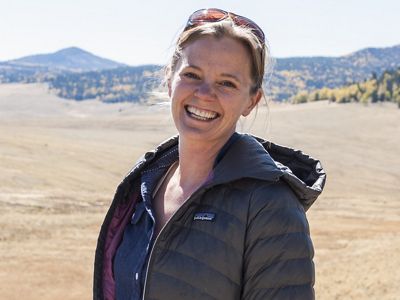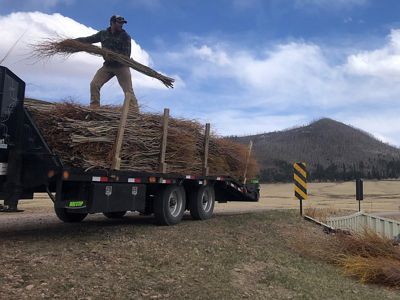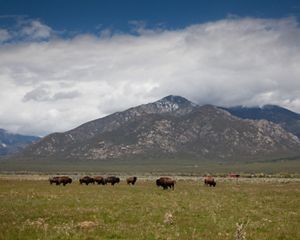
Hold It High: 3 Restoration Projects That Are Improving Life in the Rio Grande Watershed
Local conservation leaders share how restoring streams & wetlands along the Rio Grande is bringing fresh water & economic opportunity to New Mexico.
Water is central to life and livelihoods, and this is especially true in New Mexico. New Mexico’s Rio Grande and its tributaries supply water for wildlife and one million people. The health of these waterways is key to the health and economic growth of half of New Mexico’s population, including Albuquerque, Santa Fe, Native American Pueblos and other communities. But severe annual wildfires and the flooding that follows put those water sources at risk.
The Rio Grande Water Fund protects forests and boosts local economies by creating jobs and wood for products. It generates a sustainable funding source for a 20-year program to restore 600,000 acres of forests in northern New Mexico and southwestern Colorado.
When we increase the pace and scale of forest restoration—especially in the most high-risk areas in the Rio Grande watershed—we increase access to clean water and outdoor opportunities for generations of New Mexicans.
Water Fund Projects in New Mexico

Project 1: The Santa Fe Indian School Community-Based Education Program
At the Santa Fe Indian School, the students are busy conducting ongoing environmental monitoring, restoration and mapping projects in Pueblo de Cochiti, Santo Domingo Pueblo, Tesuque Pueblo and the Santa Fe River Preserve.
Working in teams with tribal youth, community volunteers and staff from the U.S. Fish and Wildlife Service, the school also manages several activities to restore fish passages along the lower Santa Fe River in Cochiti Pueblo.
One project uniting students and community members is mapping and assessing the environment along a 1.5-mile reach of the Santa Fe River, which is under restoration to build better habitat for naive plants and wildlife. Their stream restoration work exhibits practices that mitigate post-fire flooding.
“This project is about stream restoration, and demonstrating actions that can be used to mitigate flooding in a post-fire scenario,” shared Kai-t Blue-Sky, a naturalist and instructor at the Santa Fe Indian School in community-based education.
In the Cochiti Canyon, a perennial stream that flows into the Rio Grande is now planted with erosion-controlling Douglas fir, thanks to cooperation between the school, community members and the Forest and National Parks Services.
Quote: Kai-t Blue-Sky
It’s no longer about race, gender or creed—it’s about humanity.
“Planting a tree is no longer just planting a tree, but seeking biodiversity to create a better future,” Blue-Sky said.
While stabilizing river banks and learning about future careers in natural resources, Blue-Sky explained that the multi-generational education students receive is also about connecting with ancestral practices and connections with the ecosystem, their community and each other.
One species in focus is the Rio Grande cutthroat trout, a brilliantly-colored salmon family member, found in northern New Mexico and southern Colorado in the Rio Grande's tributaries. The New Mexico state fish is a traditional food source, included in tribal members’ diets and is the focus of gatherings to learn oral history, traditional practices and cultural resources from elders.
“We’re interested in making sure there are connected lifeways so that we can build resilience of language, customs and cultural lifeways,” Blue-Sky said. “Philosophies of ‘we and us’ instead of ‘me, myself and I’ begin when you look across jurisdictional boundaries—it's no longer about race, gender or creed—it's about humanity. It’s about the desire to perpetuate lifeways for energy flow in communities and to carry on spiritual storytelling pathways from older generations.”
Stay in the Loop
Be among the first to learn about TNC New Mexico's other events! Get a preview of New Mexico’s Nature News email.

Wetlands Jewels Story Map
Learn more about how Amigos Bravos are protecting wetlands across New Mexico's forests.
Explore the MapProject 2: Amigos Bravos—The Wetland Jewels Project
One of the best ways to build local resilience in the face of climate change is to protect and restore mountain wetlands. Wetlands serve as sponges within our watersheds, storing water naturally and releasing clean water over time that nourishes whole communities.
Working with wetland and GIS specialists and with input from watershed stakeholders, Amigos Bravos identified 22 high-priority wetland sites, “Wetland Jewels,” in the Carson and Santa Fe National Forests. They implemented large-scale wetland restoration projects in two Jewels sites, and plan to expand restoration work to additional areas in the future.
Rachel Conn, Amigos Bravos deputy director, explained that whether they are a single wetland or a complex of connected wetlands, each Jewel site serves as a powerhouse serving the surrounding community:
“They provide important ecological functions to the terrestrial and aquatic ecosystems and landscape—they provide stream flow maintenance, carbon sequestration, aquatic habitat, flood control, brown water recharge and essential forage for livestock and wildlife,” Conn said. “Also: They are beautiful.”

Ongoing Wetland Jewel work includes: forest planning engagement status as a restoration priority, storytelling and raising public awareness through story maps, and prioritizing restoration among key sites, including Midnight Meadow, La Jara, Gila and San Juan.
East of Taos, the La Jara Wetland Jewel project combines a watershed condition assessment, including existing impairments—such as head cuts and incised channels—and the subsequent restoration work needed. This restoration plan became seven project areas, with the first four reaching completion in 2019, and installed structures like one-rock dams, spreader inclusion and rock rundowns.
Their assessment data made it possible to create an educational Restoration Toolkit, which identifies different techniques for engaging in wetland and riparian restoration.
“We saw this as an education tool. This toolkit identifies different techniques for engaging in wetland and riparian restoration, and we use it in education and outreach,” she said.
Taos Lecture Series
Learn about the first event in the series on sustainable traditional & cultural forestry.
Read the RecapIn Area Seven in the La Jara project, the current and future focus is engaging a local collaborative, including groups like The Nature Conservancy, the Town of Taos, Taos Land Trust, the US Forest Service, the Taos Valley Asequia Association and others to revitalize local ecological health and forge agricultural connections downstream.
A significant structural addition that runs through the project is the riparian pipe rail fence, which allows grazing permittees to better manage cows in the area and adhere to the 10-day grazing limit. Other elements include an excavated channel, earthen structures and diversions to re-saturate flood plains.
“Before, when the fence was more porous, the cows were in the area much longer,” she said.
Thanks to proximity to paved highways and Taos Canyon, this project has also created a great opportunity for public education and outreach on the importance of wetland restoration. This includes field trips, prominent signage on highways about work underway, resources for how the community can learn more as well as educational content on restoration techniques employed.
Another community collaboration element of their outreach includes extensive engagement with grazing permittees and sign-off on the restoration plans.
Project 3: Rio Grande Return—Headwater Restoration
The Rio Grande Return launched the Headwater Restoration project to focus on re-establishing historic practices and species to help correct local ecological imbalances. Those could be from human-caused species eradication, grazing or logging in the New Mexico landscape.
While beavers are not present—likely poached out more than a decade ago—many historic beaver dam structures still have a big impact. They provide important lessons in restoring balance, dominating and improving existing stream systems.
Old dams integrate large woody debris that improves the wetland hydrology, saturation and contributes to enormous species diversity. They also help collect fine sediment and debris, improving soil and biodiversity.
“There’s a relic beaver dam that had impounded and collected sediments, probably over hundreds of years. And so that soil is high in nutrients and carbon storage,” shares Reid Whittlesey, Restoration Director, Rio Grande Return. “There’s been a whole forest shift, changing away from the conditions that the beavers were actually helping to manage.”

Achieving full landscape-scale restoration change required grazing management with fences, restoring ecological processes and re-introducting species such as beaver, or structures that mimic their dens.
That change is underway: One riparian restoration project in San Antonio Creek includes a number of those elements, including re-introducing woody species, such as planting willow on creek sites—sometimes by the truckload.
Construction of river bank fences help manage cattle and elk populations that can overgraze. Where allotment fences are down and need repair, cattle may graze an area for months longer than the 10-day allowance. Overgrazing stunts willows and other plants that are trying to grow back.
By increasing species and creating woody debris concentrations that mimic beaver dams, the water table grew by more than 2.5 feet and wetland species increased significantly.
“I was just wading across that pool last week to take measurements and it’s now pretty deep,” Whittlesley said.
While this project work is intended to be for improving the immediate river ecosystem, there are tangible additional positive impacts for humans in those communities and worldwide.
“We’re increasing the water storage capacity in these watersheds. Overall, while it is very much for the ecosystem, it also has tangible impacts to human communities. When you expand the riparian width, you’re also helping to attenuate the impact of flooding events and wildfire,” shared Whittlesby. “And we’re aiding in tipping the balance towards a much higher rate of carbon sequestration.”

On Wednesday, September 28, The Nature Conservancy in New Mexico led a virtual learning event called Hold it High: Stream and Wetland Restoration Benefits in New Mexico, highlighting three Water Fund projects that are restoring streams and wetlands along the Rio Grande to bring fresh water, economic opportunity and cultural wealth to New Mexico.
As New Mexico becomes more arid, storing water in upper watersheds becomes increasingly important, allowing for a longer duration of river flows downstream.
Our panel experts:
- Kai-t Blue-Sky, Instructor, Santa Fe Indian School Community Based Education Program
- Rachel Conn, Deputy Director, Amigos Bravos
- Reid Whittlesey, Restoration Director, Rio Grande Return
- Q&A moderator: Matt Piccarello, TNC Forest & Watershed Health Manager
- Moderated by Martha Cooper, TNC’s Freshwater Program Director for New Mexico
Watch the full recording here.
Thanks to the Taos Ski Valley Foundation for sponsoring this event.
*This virtual event report has been edited for length and clarity.


